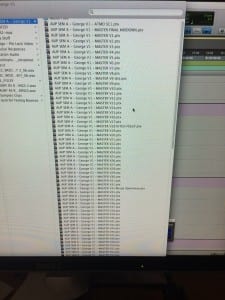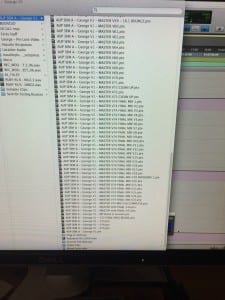(Outcomes in this blog – <IN3> – <PER 1 + 3> – <GR 1, 2 + 5>)
I very much wanted to tackle the sound design for the futuristic, post-nanotech city scene from Immort as part of my work on this project, and was able to make a start on this as the film was being shot thanks to early provision of an animatic of the film. Below is the evolution of the scene from my initial mockup to the picture lock version handed over to the supervisor who also mixed the film.
Immort’s supervisor had initially produced a detailed sound design plan for the film, which formed the basis of my initial approach to the scene’s construction.
https://www.youtube.com/watch?v=xOPA2XrnVUg
I looked immediately to Blade Runner – which includes the great street scene of sci-fi film with an insanely complex audio mix carried out by Graham V Hartstone – but the feel for Immort is intended to be different in terms of the behaviour of the characters. Lot’s of the specific things seen on screen in Blade Runner have their own tiny, almost momentary sound narrative set against the extreme bustling of the city defined by sirens, wails and pulsing humanity. By contrast, people in Immort’s world are quiet and contented, even if they are constantly beset by their connectedness thanks to their constant HUD’s. My initial mockup backdrop tried to hit similar notes to Blade Runner in the sound of humanity being strongly signified, though it’s very difficult without the specificity of actual picture available to work from. The mockup below is constructed almost entirely of heavily manipulated samples, with a couple of simple keyboard drones from Protools soft synths. It’s ugly, but gives an idea of where I was going. <IN3>
I had to change approach after discussing with Immort’s supervisor during the session in which I constructed it. He’d just come off set for the film with a better interpretation of the directors requirements and the outcome of the actual shoot for the scene. His location experience with the film told him that the extras would be considerably sparser than first implied, so lots of humanity in the audio pallette would likely not work. We arrived at an idea of generally quieting the people with bursts of the sound of their personal soundtrack as they pass-by, and the base layers defined by the unearthly hum of a nano-technological city. <GR5 + PER1>
My first attempt at following this direction up was done to a rough, no vis-fx rough cut of the film, and can be seen below –
Seeing this actual picture, the visuals turn out to be much more down to earth. Both budget constraints and a lack of extras mean the scene has ended up much sparser and near-future than the one I initially envisioned even if we discount the lack of VFX in this cut for the moment. As such I retooled the atmos more in the direction of Invasion of The Body Snatchers (the 1978 version), muting the drone of the people and trying to bring out a sense of disconnectedness (largely using manipulated foley FX and further samples, in line with the protaganists desire to be unplugged from the matrix and the suggestion of enslavement to their technology causing them to take greater care as they move around the real world. <GR5>
Instead of solid footsteps the extras feet are muted and shuffling, for which I referred to multiple scenes from Bodysnatchers like the scene linked below which dispenses almost entirely with ‘human’ foley even in crowded scenes to emphasise the distinction between the protaganists and the masses. This feel was fortuitously enabled by the incredibly well regimented ‘crowd’ at the end of the scene. There is a nod to the Blade Runner approach however, in that the HUD’s of some of the extras are momentarily given life in the audio realm as the protaganist passes them. <IN3>
Finally, this work was passed over to Immort’s audio supervisor in stem form and was incorporated into his final mix of the scene, which is backed by a music track to heighten the sense of chase and sounds which relate to the new visual FX absent from earlier cuts. <GR1 + GR2>
Reflecting on this work, I think the whole process here demonstrates once again the power of picture over the audio dimension and the importance of finding synergistic balance between them. As such I think I may have wasted a little time attempting to construct anything useful for this scene from the animatic and should have foreseen that the production would not achieve the levels of production they desired, though the early work was still very useful as an opportunity to dissect the scene’s from Blade Runner and Bodysnatcher’s critically and take lessons from them, and it certainly informed the final piece in an overall positive way in the end. <PER3>
Furthermore, the process is an example of the way the group of audio producers collaborated on aspects of the films. If I had been limited to working on the film I supervised, which was shot entirely in one location, I would have been unable to build, experiment with and compare and contrast the atmosphere work in various films as I did here, a process with which I was able to usefully fill time prior to the arrival of work on my own film, which in turn benefited the group outcome. <GR1 + GR2 + PER1>
—————————— 750 Words
- [IN3] To better my understanding of sound design with at least some reference to the science fiction genre – (Sound Effects Editor)
Construction and evolution of the audio for the scene – Application of skills and conduct in production
- [PER3] To expand my knowledge of the theory of and audio techniques deployed in films similar to or influential upon those we will deliver.
[GR5] To produce soundtracks comprising of foley, SFX, dialogue, music and atmospheres to client specifications that synergistically support the other components of their films.
Reflection on the work – Individual reflection on learning and team role + Process Management.
- [PER1] To develop a better understanding of the pros and cons of business structures, processes and agreements which might enable film audio producers to collaborate on multiple projects.
[GR1] To professionally operate as a small to medium size company (or other recognisable business entity) in the audio production / post-production field might.
[GR2] To organise and fulfil an operating strategy and schedule which deals with multiple productions simultaneously, and which maximises efficiency and minimises issues or risks to delivery.


